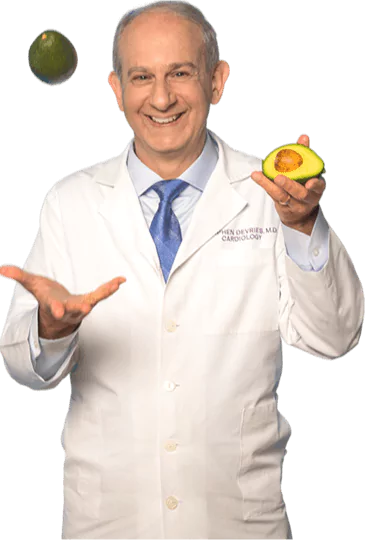

Earn a personalized certificate of achievement after each module!
Learn Answers to Common Nutrition Questions
Not a video or slideshow—you learn by active discovery.
15 Minutes of Interactive Learning!
In this module, you’ll learn the answers to these key questions.
Should I Consider a Low-Fat Diet?
- Is it better if I avoid eating fat altogether?
- Do all fats have the same effect on health?
- What are the most important fats to cut in a low-fat diet?
- What are the possible pitfalls of a low-fat diet?
What Do I Need to Know About Healthy Fats?
- Which foods contain healthy fats?
- What is the health impact of various grades of olive oil?
- Can heat degrade healthy fats?
- Are trans fats still a concern?
What Makes Omega-3 Fats Special?
- How do Omega-3 fats improve heart health?
- What foods have Omega-3 fats?
- Are all Omega-3 fats the same?
- Can vegans consume the same kind of Omega-3s found in fish?
What's the Latest on Cholesterol?
- Which foods contain cholesterol?
- What’s the difference between “good” cholesterol and “bad” cholesterol?
- Will eating foods with cholesterol raise my blood cholesterol?
- Can I now eat as many eggs as I want?
Why All the Controversy About Saturated Fats?
- Why is there still some concern about saturated fat?
- Which foods have the most saturated fat?
- Does saturated fat affect blood cholesterol levels?
- What are the best replacements for saturated fat?
Explore All the Modules in this Program
Learn the Truth About Dietary Fat
For a long time, doctors advised patients to cut way back on fat. That’s because fat has been linked to some serious health problems, like heart disease and stroke. But on the flip side, fat actually helps our bodies absorb certain vitamins—and some fats are even helpful for brain development.
So, is fat good? Or bad? According to the latest evidence, it depends a lot on the kind of fat you’re talking about. Most foods contain a combination of fats, but often one kind predominates. Let’s explore the four main types of fat. We’ll also cover important facts about cholesterol, and which fats to use in high-temperature cooking.
Types of Fat: What You Should Know
So, is fat good? Or bad? According to the latest evidence, it depends a lot on the kind of fat you’re talking about.
Most foods contain a combination of fats, but often one kind predominates. In our interactive learning experience on dietary fats, we explore four main types of fat, as well as cholesterol and which fats to use in high-temperature cooking.
Saturated Fats
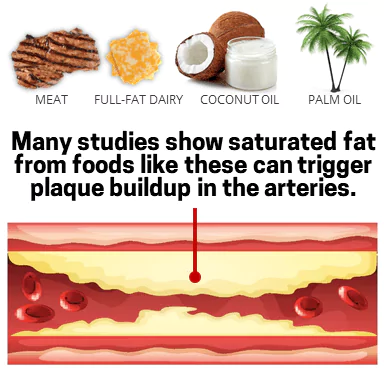 Saturated fats are concentrated in meat and full-fat dairy products. They’re also found in some non-animal sources, like coconut oil and palm oil. Studies show that most saturated fats are triggers for plaque buildup in the arteries.
Saturated fats are concentrated in meat and full-fat dairy products. They’re also found in some non-animal sources, like coconut oil and palm oil. Studies show that most saturated fats are triggers for plaque buildup in the arteries.
Often, people think that if they just eat less saturated fat, they’ll lower their risk of heart problems. But it’s not quite that simple. An important point to consider is: when you cut down on saturated fat, what will you eat in its place? Many people end up replacing saturated fat with carbs—especially refined ones—a swap that offers no health advantage at all! But if you replace saturated fat with healthier options—such as whole grains and vegetables, or with polyunsaturated fat such as the Omega-3 found in fish—you’ll be taking a positive step toward better health.
Polyunsaturated Fats
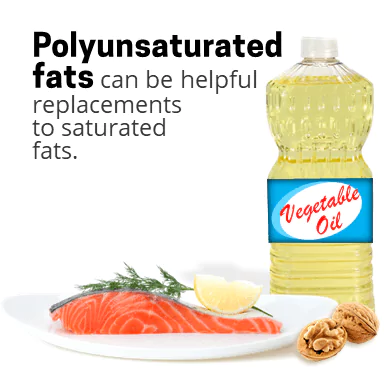 Polyunsaturated fat is a type of fat that can actually be helpful to our bodies. It’s found in several types of plant oils, walnuts, flax, and fatty fish like salmon. People who replace foods that are high in saturated fat (like meat and cheese) with foods that have healthier fats (like vegetable oil and fish) often experience significant health benefits.
Polyunsaturated fat is a type of fat that can actually be helpful to our bodies. It’s found in several types of plant oils, walnuts, flax, and fatty fish like salmon. People who replace foods that are high in saturated fat (like meat and cheese) with foods that have healthier fats (like vegetable oil and fish) often experience significant health benefits.
Omega-3 and Omega-6
You’ve probably heard of Omega-3 and Omega-6 fatty acids. They are both part of the family of polyunsaturated fats. They’re called “essential” fatty acids because our bodies can’t make them on their own—we have to get them from the foods we eat.
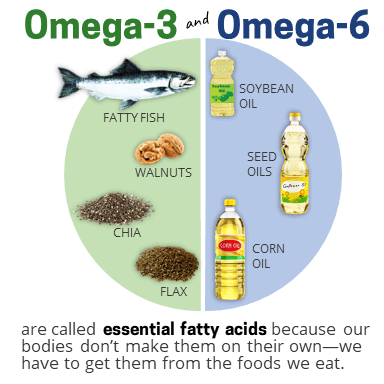 If you’re like most people, you have no problem getting more than enough Omega-6. Most diets in the U.S. are loaded with Omega-6 fats as found in soybean oil, seed oils, and corn oil—all of which are common ingredients in many processed foods.
If you’re like most people, you have no problem getting more than enough Omega-6. Most diets in the U.S. are loaded with Omega-6 fats as found in soybean oil, seed oils, and corn oil—all of which are common ingredients in many processed foods.
Omega-3, on the other hand, is not as prevalent in U.S. diets. It’s found in fish such as salmon, sardines, and halibut—as well as plant sources such as walnuts, flax, and chia. The plant sources of Omega-3 are a type called ALA, and the fish sources have different types of Omega-3, called EPA and DHA. This might all sound like a jumble of letters, but it’s really an important distinction, and here’s why: the EPA and DHA in fish are the kinds of Omega-3 that are the most biologically active in our bodies.
But why are EPA and DHA such a big deal? Check out this amazing list:
- They reduce a type of fat in the blood called triglycerides.
- They reduce blood pressure.
- They can help prevent blood clots.
- They reduce inflammation.
- They reduce the risk of heart disease.
- And some research even shows that they support cognitive function, such as easing depression and helping with attention problems.
How to Get Enough Omega-3
To get the most beneficial types of Omega-3 (that is, EPA and DHA), a good goal is to eat 2 or more servings of fish a week. But be aware that some fish are higher in Omega-3 than others. And you’ll want to avoid consuming too much fish that is known to have high mercury content. Our interactive module on dietary fats has helpful resources that will make it easier to choose the best fish options.
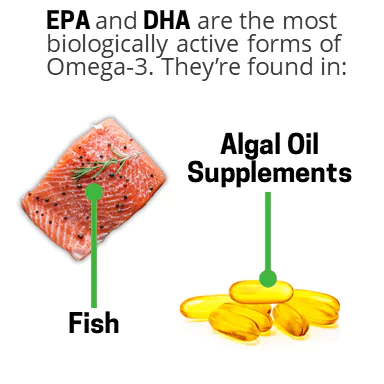
For people who don’t like or won’t eat fish, another option is an algal oil supplement. These are made from algae but, just like fish, they contain EPA and DHA—the most active forms of Omega-3. It’s also a good idea to load up on Omega-3 from plant sources, like:
- Walnuts
- Flax and Flaxseed oil, and
- Chia seeds
But remember: these contain mostly ALA, which is the type of Omega-3 that is less active.
Monounsaturated Fats
Monounsaturated fats are found in foods like olives, olive oil, almonds, and avocados. Of all the fats, monounsaturates are one of the shining stars—in fact, medical studies have shown that patients who use it to replace saturated fat will cut their risk of heart disease. Also, monounsaturated fats are likely responsible for many of the health benefits of a Mediterranean-style diet.
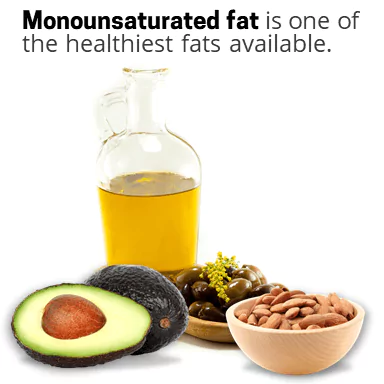 Can you predict what happens when you replaced saturated fats with monounsaturated? Here are some of the results:
Can you predict what happens when you replaced saturated fats with monounsaturated? Here are some of the results:
- LDL cholesterol drops. LDL is the “bad” cholesterol in our blood. It collects in blood-vessel walls, causing blockages.
- HDL cholesterol increases. HDL is the “good” cholesterol in our blood. It moves through our blood vessels, removing LDL (the “bad” cholesterol).
- Blood-clotting factors decrease. This is helpful, because when blood clots too much, it can inhibit circulation and lead to heart attack, stroke, organ damage, or even death.
What Kind of Olive Oil is Best?
A common—and delicious—source of monounsaturated fat is olive oil. If you have a choice, extra-virgin olive oil is best. That’s because it has a higher content of polyphenols. These are plant-based compounds that have antioxidant and anti-inflammatory properties. Polyphenols are also known to increase the level of the “good” cholesterol, HDL.
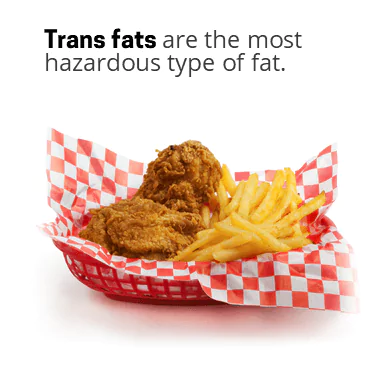 Trans Fats
Trans Fats
Trans fats are the most hazardous type of fat. They do a double-whammy on cholesterol, because they not only raise LDL (the “bad” cholesterol), they also lower HDL (the “good” kind of cholesterol). This can lead to all kinds of health problems, like heart attacks and strokes. Trans fats also trigger inflammation, which plays a key role in many chronic diseases.
For a long time, artificial trans fats were a key ingredient in processed foods and fried foods because they’re inexpensive, and they also prolong a food’s shelf life. But fortunately, recent legislation has essentially eliminated artificial trans fats from the food supply.
Cholesterol
Cholesterol is a type of fat found in our blood. Our bodies use it in the lining of our cells, and to make hormones.
When doctors check your cholesterol level, they often measure the type of cholesterol, which includes:
- Your LDL, which is a “bad” type of cholesterol that collects in blood-vessel walls, causing blockages,
- And your HDL, which is the “good” cholesterol that helps remove blockages and lowers your cardiovascular risk.
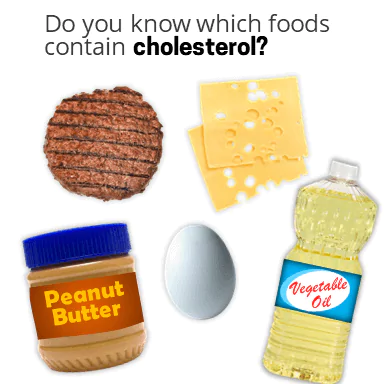 Your body makes cholesterol naturally in your liver. You can also get cholesterol from food, but that isn’t really necessary, since our bodies automatically produce all the cholesterol we need, without added cholesterol from the diet.
Your body makes cholesterol naturally in your liver. You can also get cholesterol from food, but that isn’t really necessary, since our bodies automatically produce all the cholesterol we need, without added cholesterol from the diet.
Do you know which foods contain cholesterol, and which don’t? An easy way to tell: cholesterol is found only in animal-based products. Cholesterol is never found in foods that come solely from plants.
Are Eggs Healthy?
Eggs are the largest source of cholesterol in our diets. But beef, chicken, and cheese are also high in cholesterol. Some recent media reports imply that eating foods with cholesterol might not be so bad. But there’s still reason to be cautious, and here’s why. Cholesterol in our food does cause our bodies’ LDL (or “bad” cholesterol) to rise—not by a lot, but it’s still significant. Bottom line? It’s a good idea to eat as little dietary cholesterol as possible.
Cooking Oil
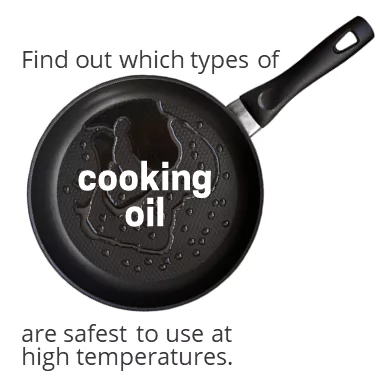
What about the fats you use to cook with? The kind of cooking oil you use can be really important, because not all cooking oils are safe to consume if they’re heated to very high temperatures. In fact, if you heat oil to its smoke point, it begins to degrade into potentially carcinogenic chemicals.
Each oil has a unique temperature at which it begins to smoke—called its smoke point. Here are some important rules of thumb:
- For sautéing, you can use extra-virgin olive oil if you don’t turn the heat up all the way up and you limit the cooking time.
- For higher-temperature cooking or prolonged cooking, consider grapeseed or avocado oil, which have higher smoke points.
- And avoid heating oil to the point that it begins to smoke.
- If oil does get heated to the point of smoking, don’t use it for cooking. Get rid of it.
Discover How to Choose the Healthiest Types of Fat
You can learn how to make the best choices about the fat you include in your diet, starting right now. Click the button below to take our fun and interactive mini-course on the truth about dietary fat!

